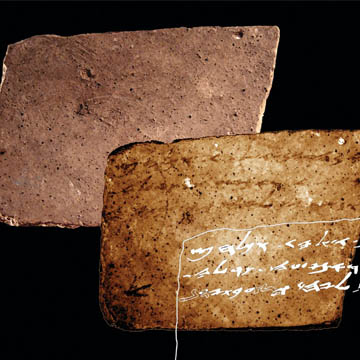
Multispectral imaging revealed an inscription on a patch of 2,600-year-old pottery previously thought to be blank. [Image: American Friends of Tel Aviv University]
Using multispectral (MS) imaging, Israeli researchers at Tel Aviv University (TAU) have discovered a previously invisible inscription—including an ancient request for wine—on a pottery shard more than 2,600 years old (PLOS ONE, doi: journal.pone.0178400). The researchers believe that the discovery highlights the power of MS imaging for documenting ancient inscriptions that might otherwise be missed. And they recommend the technique’s use for routine on-site screening of archeological samples at sites where hidden written materials might lurk, for “a better understanding of the past.”
Keys to the past
The pottery fragment in question comes from a military outpost at Tel Arad, a fortress west of the Dead Sea in the ancient Kingdom of Judah. The fragment, or ostracon, dates from around 600 BCE, only a decade or two before the kingdom’s destruction and the onset of Babylonian rule in 586 BCE. Given the tendency of papyrus documents from that period to decay, the texts found such ostraca—often dry recountings of military and trade information—constitute the main written record found in archeological sites. But the writing on such ancient fragments is extremely fragile and prone to fading and deterioration.
For that reason, newly discovered ostraca at archaeological sites commonly undergo imaging with a standard digital camera—and, in some cases, infrared imaging—to capture their texts at the time of their unearthing. In 2012, the TAU research team, led by Eli Piasetzky and Israel Finkelstein, demonstrated that MS imaging could provide a more legible view of ostracon inscriptions. That more legible view, they suggested, could aid in pulling more information from these challenging fragments, which are often just five to ten centimeters in length.
Tricked-out camera
To test out MS imaging’s advantages on a real-world problem, the TUV team began by modding a standard Canon SLR 450D digital camera to make it multispectral-ready. The team’s previous work had shown that the optimal imaging wavelength for ostraca lies in the 550-to-950-nm range. So they pulled out the camera’s infrared-cut filter to improve the camera’s sensitivity to the longwave side of that frequency band. Commercial bandpass filters sliced the spectrum from the camera into ten channels, used to create the spectral “cubes” used in the MS imaging.
The researchers then pointed this system at the Tel Arad ostrocon, discovered in the 1960s and on display at a Jerusalem museum ever since. Previous work on the fragment had revealed, on the ostrocon’s front side, an inscription detailing military finances and logistics—unsurprising, considering Tel Arad’s place as a prominent military outpost. The TAU team’s MS imaging, however, revealed 45 characters in that front-side inscription that had previously been missed, and that could, according to the researchers, significantly enrich the inscription’s interpretation.
From invisible to visible
Even more surprising, MS imaging of the ostracon’s back side, or verso—previously thought to be completely blank—revealed three lines of extremely faded text. The newly discovered text continued the discussion of money transfers from the front, and was addressed to the soldier in charge of the compound. “Many of these inscriptions are addressed to Elyashiv, the quartermaster of the fortress,” Anat Mendel-Geberovich of TAU’s department of archeology said in a press release. “They deal with the logistics of the outpost, such as the supply of flour, wine and oil to subordinate units.”
With the help of the MS imaging technique, the TAU team deciphered 17 “new” words from 50 characters on the ostracon’s back. The new text has a decidedly oenological bent: The previously unseen inscription begins with a request for wine (“If there is any wine send …”) and later mentions that “Ge’alyahu has taken a bat of sparkling wine” (a bat was an ancient measurement unit).
Preservation tool
“The newly revealed inscription features an administrative text, like most of the Arad inscriptions,” says Mendel-Geberovich. “Its importance lies in the fact that each new line, word, and even a single sign is a precious addition to what we know about the First Temple period.”
Given that importance—and given the swift rate of ink’s deterioration on these pottery fragments, which led, in this case, to an inscription being completely missed for more than 50 years—the TAU researchers argue that their work demonstrates the “urgent” need to apply MS imaging to “all ostraca unearthed since the early days of biblical archaeology.” And they suggest that, while it may add a layer of complication to the work, archaeologists in the field should carry out multispectral screenings on both sides of newly excavated ostraca as well. “The prospective gains for a better understanding of the past,” the TAU team concludes, “make the effort worthwhile.”
